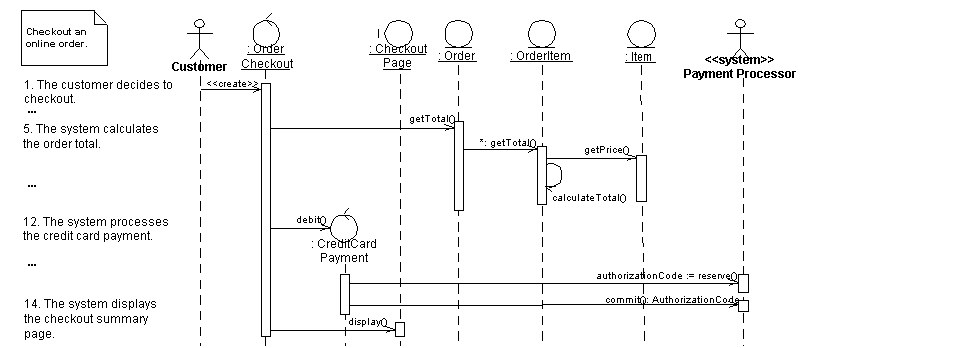UML Sequence Diagrams: Diagramming Guidelines
- Validate and flesh out the logic of a usage scenario. A usage scenario is exactly what its name indicates – the description of a potential way that your system is used. The logic of a usage scenario may be part of a use case, perhaps an alternate course; one entire pass through a use case, such as the logic described by the basic course of action or a portion of the basic course of action plus one or more alternate scenarios; or a pass through the logic contained in several use cases, for example a student enrolls in the university then immediately enrolls in three seminars.
- Explore your design because they provide a way for you to visually step through invocation of the operations defined by your classes.
- To detect bottlenecks within an object-oriented design. By looking at what messages are being sent to an object, and by looking at roughly how long it takes to run the invoked method, you quickly get an understanding of where you need to change your design to distribute the load within your system. In fact some CASE tools even enable you to simulate this aspect of your software.
- Give you a feel for which classes in your application are going to be complex, which in turn is an indication that you may need to draw state chart diagrams for those classes.
There are guidelines for:
1. General Guidelines
Figure 1. Enrolling a student.

Figure 2. Checking out an online order.

- Strive for Left-To-Right Ordering Of Messages
- Layer The Classifiers
- Name Actors Consistently With Your Use Case Diagrams
- Name Classes Consistently With Your Class Diagrams
- An Actor Can Have The Same Name as a Class
- Include a Prose Description of the Logic
- Place Human and Organization Actors On the Left-Most Side of Your Diagram
- Place Reactive System Actors on the Right-Most Side of Your Diagram
- Place Proactive System Actors on the Left-Most Side of Your Diagram
- Avoid Modeling Object Destruction
2. Guidelines for Classifiers
Important: Naming conventions for classifiers are described elsewhere. In particular, naming conventions for classes and interfaces are described in Style Guidelines for UML Class Diagrams, for use cases in Style Guidelines for UML Use Case Diagrams, and for components in Style Guidelines for UML Component Diagrams.
Figure 3. Transferring funds between accounts.

- Name Objects When You Refer To Them In Messages
- Name Objects When Several of the Same Type Exist
- Apply Textual Stereotypes Consistently
- Apply Visual Stereotypes Sparingly
- Focus on Critical Interactions
3. Message Guidelines
Important: Naming conventions for operation signatures, guidelines that are pertinent to naming messages, parameters, and return values, are described in detail in Style Guidelines for UML Class Diagrams.
- Justify Message Names Beside the Arrowhead
- Create Objects Directly
- Apply Operation Signatures for Software Messages
- Use Prose for Messages Involving Human and Organization Actors
- Prefer Names Over Types for Parameters
- Indicate Types as Parameter Placeholders
- Messages to Classes are Implemented as Static Operations
- Apply the <> Stereotype for Use Case Invocations
4. Guidelines for Return Values
- Do Not Model a Return Value When it is Obvious What is Being Returned
- Model a Return Value Only When You Need to Refer to It Elsewhere
- Justify Return Values Beside the Arrowhead
- Model Return Values As Part of a Method Invocation
- Indicate Types as Return Value Placeholders
- Explicitly Indicate The Actual Value for Simple Values




